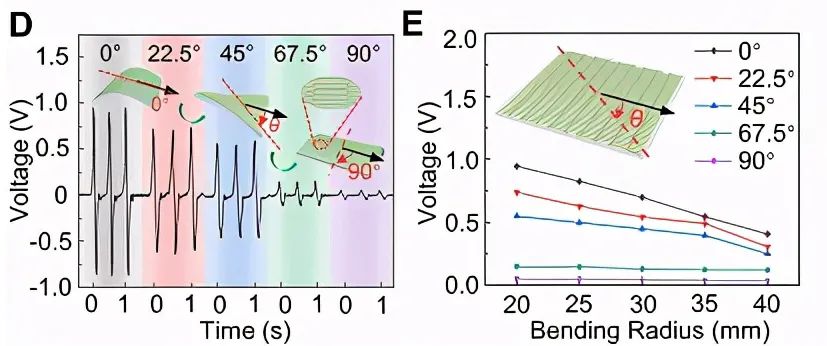A new sensor and joint motion monitoring system to remind users to exercise regularly
Perhaps you have had the experience of sitting still and using a computer or mobile phone for a long time, and end up feeling pain in your shoulder, neck, waist and back. A sensing system that can monitor joint motions and remind you to move and stretch regularly may help keep your joints healthy. A research team led by scientists at City University of Hong Kong (CityU) developed a new sensor with a unique composite and kirigami structure, which can distinguish different modes of joint motions. On this basis, the team has also established a system that can monitor the motions of cervical spines and shoulder joints, which can help prevent joint disorders and facilitate the rehabilitation of patients.
The research was led by Dr Yang Zhengbao, Assistant Professor in the Department of Mechanical Engineering (MNE) of CityU. The findings have been published in the science journal Science Advances under the title “Highly anisotropic and flexible piezoceramic kirigami for preventing joint disorders”.
Monitor and distinguish joint motion information simultaneously
“Different from traditional wearable medical care sensor, the kirigami-structured piezoelectric sensor developed by us can monitor and distinguish various information of joint motions at the same time, including bending direction, bending radius and modes of motions. A single sensor can already perform all the above functions,” said Dr Yang.

At present, most of the wearable sensors used to monitor the motion signals of human joints have complex structures and lack flexibility. Besides, they cannot fully record the motion information of joints, greatly limiting their actual application. Inspired by the fact that kirigami can transform structures from stiff to stretchable forms, Dr Yang and his team successfully developed a stretchable piezoelectric ceramic network with a two-dimensional honeycomb-like kirigami structure. The team used this material as the core sensing component and make a new sensor in combination with special designs.
The sensor uses PET plastic films as the flexible substrate and has two layers of flexible piezoelectric composite upon it, while on top is covered with PDMS (a kind of organic silicon), which features flexibility, so that the sensor can be closely attached to the surface of human joints.
Piezoelectricity refers to the exchange of mechanical energy and electrical energy in dielectric materials. After attaching the sensor to the skin, it will deform when the joints move and then generate electronic signals due to the direct piezoelectric effect. The breakthrough made by the team is that deformation of the kirigami-structured piezoceramic network in the sensor can achieve piezoelectric anisotropy, meaning that the electronic signals generated are different when the applied forces are coming from different motion directions.
Since signals can show piezoelectric anisotropy, the load pressure from different motion directions can be distinguished. Accordingly, researchers have figured out the relationship between different bending directions and amplitudes and output voltages.
The movie shows that the top sensor and bottom sensor can sense the motions of the cervical spine in different directions and generate different signals. (DOI number: 10.1126/sciadv.abf0795)

The team attached the sensor to human necks for experiments and verified that the sensor could identify four types of deformation modes from different joint motions, including left-right twisting or back-forth moving of necks, with an accuracy of over 95%. The team also attached the sensor to human shoulders for experiments, and joint motions were also identified with an accuracy of over 95%.
The research team has made use of this sensor to establish an alarm system to monitor and judge the motions of human cervical spines and shoulder joints to remind users whether they are sedentary. In experiments, the team first set the minimum number of motions that should be detected within the test time frame in the system, for example, at least 10 times of joint motions within 30 minutes. Then the team attached the sensor to the necks and shoulders of subjects and the piezoceramic signals were collected for monitoring. The experiments showed that if the system detected that the subject had moved less than 10 times in 30 minutes, a warning would pop up on the screen of the computer, indicating that “your neck needs to move more” or “your shoulder needs to move more”.
Motion monitoring and alarm system for cervical spines and shoulder joints. (DOI number: 10.1126/sciadv.abf0795)
Dr Yang said that this new flexible piezoceramic composite can be used in sensors, actuators and even energy harvesting devices. He also stressed that this new sensor has many advantages: it has a large measurement range with highly sensitive and highly anisotropic piezoelectric responses; it has multi-functional measurement ability and can be used for long-term monitoring. The concept of the design also provides a new solution for the emerging stretchable and multifunctional piezoelectric components.
Dr Yang believed that the manufacturing of this sensor and its application in joint motion monitoring will help promote the development of flexible electronic devices in health monitoring equipment, and contribute to the prevention and rehabilitation of joint disorders.
Dr Yang is the corresponding author of this paper, while Hong Ying and Wang Biao, PhD students of CityU’s MNE, are the first authors. Other collaborators include Lin Weikang, Jin Lihan, Liu Shiyuan from the same department and Associate Professor Dr Luo Xiaowei from the Department of Architecture and Civil Engineering of CityU, as well as some collaborators from the University of Hong Kong.
The research was funded by CityU, the National Natural Science Foundation of China and the Hong Kong Research Grants Council.
DOI number: 10.1126/sciadv.abf0795
